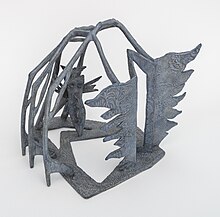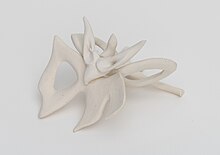Helen Ramsaran | |
|---|---|
 | |
| Born | May 11, 1943 Bryan, Texas, U.S. |
| Education |
|
| Known for | Bronze, clay, and encaustic sculpture, papermaking |
| Website | www |
Helen Evans Ramsaran (born May 11, 1943[2]) is an American sculptor. Her work explores the primordial world of ancient rituals, mysterious fossilized remains, mystic forces, and African inspired architecture.[3] Ramsaran's work was first inspired by a trip to Africa in 1981, and although her sculpture is inanimate, there is a lurking sense of humanity's presence.[4] Her recent work explores the effects of climate change on life sustaining systems and resources, specifically marine ecosystems and plant and animal species.
Helen Ramsaran was born in Bryan, Texas in 1943[2] to parents Elizabeth and Fred Evans.[5] She received a Bachelor of Science degree in Art Education (1965) and a Masters of Fine Art in sculpture (1968) from Ohio State University, where she studied bronze casting under David Black and welding with John Freeman. From 1968 to 1969, Ramsaran taught at Florida A&M University and later at Bowie State University in Maryland from 1970 to 1973.[2] She studied photography at the New School for Social Research in New York (1973–74), and anatomical drawing at the Art Students League in New York from 1975 to 1976. Ramsaran retired as an associate professor of art at John Jay College of the City of University of New York in 2008.
Ramsaran moved to New York City in 1973. Shortly thereafter (1978), she created a series of bronze relief sculptures called Visual Tales. This is her only series that is autobiographical in its statement and assumes the form of a visual narrative. The images and forms are somewhat calligraphic, thus posing some very delicate and challenging casting problems. In executing this body of work at the Johnson Atelier Technical Institute of Sculpture in Princeton, New Jersey, Ramsaran was able to perfect the technique of casting very delicate bronze sculptures.
Ramsaran's bronze sculptures were typically small-scale compositions that occasionally featured multiple figures. Her delicate and fluid bronze technique is exemplified in her 1976 sculpture, Survivors. The work is small (15 x 15 x 14 inches) and shows three thin, elongated, and curved figures planted to the base of undulating surfaces that is fixed to a wooden plank. The emaciated and abstracted figures effectively convey Ramsaran's social message that is “the plight of the poor and starving and their struggle against the manipulative forces that oppress them."[5] Speaking about this piece, Ramsaran said it "was not an easy one to create, but I felt that it was a necessary one”.[5] Her motivation came from a New York Times article that proposed some countries in the Sahel region may always struggle despite food aid, suggesting to prioritize economically resourceful countries for significant food supplies while considering alternative approaches for the more challenging cases, resembling the principle of triage.[5] Ramsaran said, "I was enraged because I have seen so many economically deprived people survive by sheer determination and pride, and for that reason I would never entertain the notion of writing anyone off. Therefore I created this sculpture for all of those people who have been written off and yet managed to survive."[5] The elongated forms and their spatial interplay also evoke the artistic style of Giacometti, who drew inspiration from African sculptural design principles.[5]

In the 1980s, Ramsaran's work took a major shift and developed into an exploration of ancient rituals, ancient African oral traditions, ancient myths, mysterious fossilized remains, supernatural power, and African inspired architecture. Although her sculpture during this period and beyond is inanimate, there is a lurking sense of humanity's presence. The subtle carvings on many of Ramsaran's bronze sculptures are meant to represent African scarification and elements in nature, such as lighting and rain that mark the change in planting seasons and, that speak of a lost reverence for nature and its life-sustaining power.
The research for Ramsaran's older works involved extensive travel, over a thirty-year period, throughout Africa, Europe, Mexico, China, and Japan. During the early 80's she traveled to Pietrasanta in Italy where she set up a small studio and spent several months casting in bronze. A few of the most pivotal moments in her research came when she visited Mexico (1982) where she observed the ancient sculpture and architecture of the Toltecs, Mayans, Zapotecs and Aztecs; Japan (1984) where she learned the delicate art of traditional Japanese papermaking or Washi while being apprenticed to the papermaker, Hiroyuki Fukunishi; and, in Zimbabwe (1987–1988) where she created a group of twenty stone carvings and bronze sculptures called Prehistoric Stamps that suggest the prehistoric origins of seeds, fossils, animals, and the Shona, Karanga and Ndebele people of the region. The overwhelming presence of granite boulders, in Zimbabwe, adorned with prehistoric, red ochre paintings of warriors and animals would forever shape Helen's approach to her work going forward.
Similarly, after her experiences in Japan she created a series of experimental sculptures, in handmade paper called The Secret Myths. These works represent enlarged amulets inscribed with brightly colored symbols from African mythology. The Sanctuary Group consists of a series of large bronze sculptures informed by an age-old initiation ritual of the Poro and other associations, which takes place in the deep sacred grove of trees in the Ivory Coast. These works were included in Ramsaran's solo show at the Chrysler Museum of Art and the Studio Museum in Harlem. Ramasran's extensive research on the Dogon sacred sites in Mali informs her series of bronze sculpture that investigates the idea of the shrine as an actual place of refuge for the living and the deceased. This exploration into the idea of "house" was also an outgrowth of Ramsaran's research on African cosmology especially in the construction of houses.
In 1998, Ramsaran produced an art work entitled Kuca: A Well Worn Path. This path measured approximately 125 feet long and 18 to 24 inches wide and was composed of approximately 100 bronze segments linked together to form a serpentine design. In the language of the Batammaliba people, kuca refers to a path, often associated with the concept of a place. Ramsaran comments on the profound multi-layered meaning this word holds in relationship to her sculptures:
As a sculpture, the idea of the path and the way it evolves intrigues me. While we are familiar with paths and have probably contributed to forming numerous paths in nature, it is a path, as it is understood in the metaphysical sense, which inspires me more as an artist. Perhaps, it is because the meaning is a bit more elusive, inviting complex expressions and is open to multiple levels of interpretations.[6]

According to Suzanne Preston Blier, The Anatomy of Architecture, "Paths constitute a frequently used metaphor in the Batammaliba ceremony and thought. Paths are commonly used to refer to the idea of destiny (one's path in life), are closely identified with the idea of history (a path through time), are employed as a frequent reference to identity (each person follow his or her own distinct path), and are often used to suggest proper conduct (the correct path of behavior). In local ritual (among the Batammaliba) and symbolic contents, the path is seen to be that element that distinguishes and gives identity (a sense of place) to all living forms."[6]

Ramsaran's recent series, executed in carved white clay, is not as intricate as the earlier works but they still communicate the same sophistication and physical tension. These pieces are intended to represent the dying off of the coral reef and other life-sustaining systems due to the effects of climate change.
((cite journal)): Cite journal requires |journal= (help)
| International | |
|---|---|
| National | |
| Artists | |